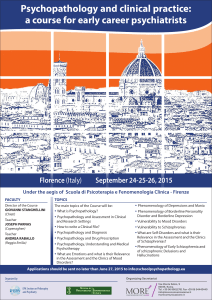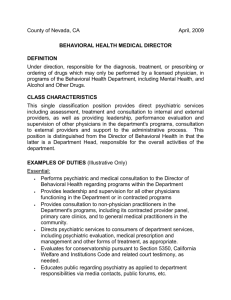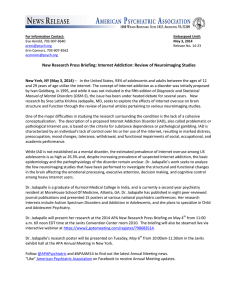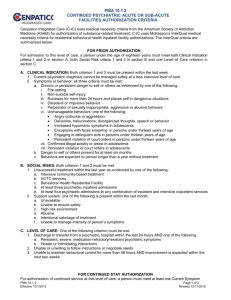indicate significant at pPsychiatry
advertisement
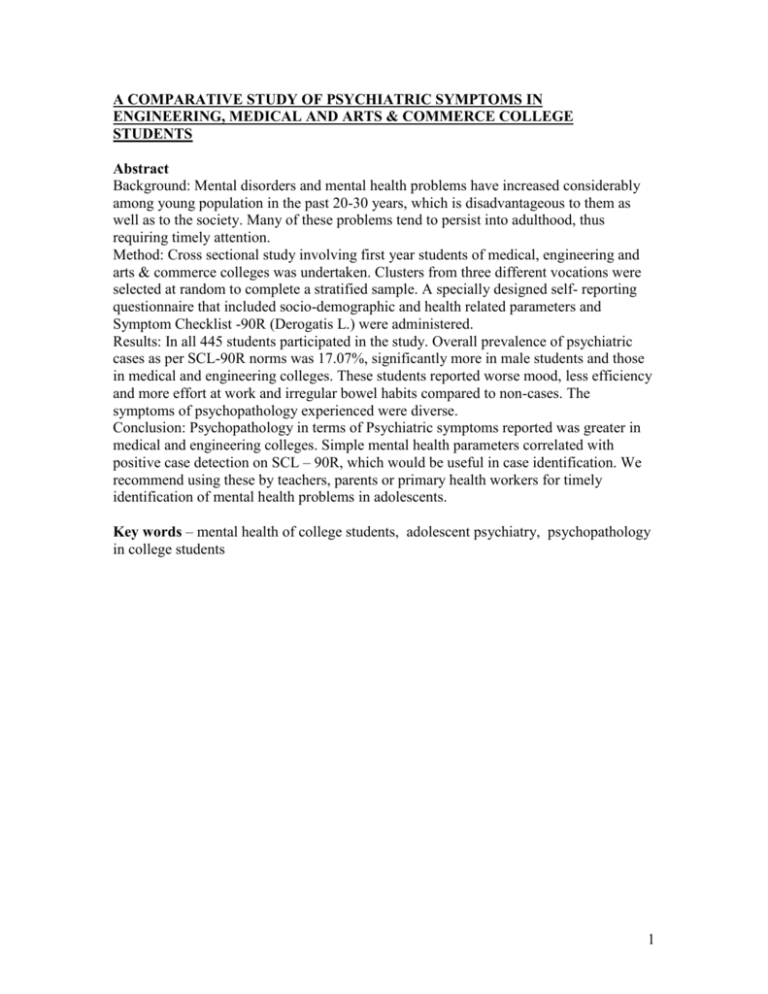
A COMPARATIVE STUDY OF PSYCHIATRIC SYMPTOMS IN ENGINEERING, MEDICAL AND ARTS & COMMERCE COLLEGE STUDENTS Abstract Background: Mental disorders and mental health problems have increased considerably among young population in the past 20-30 years, which is disadvantageous to them as well as to the society. Many of these problems tend to persist into adulthood, thus requiring timely attention. Method: Cross sectional study involving first year students of medical, engineering and arts & commerce colleges was undertaken. Clusters from three different vocations were selected at random to complete a stratified sample. A specially designed self- reporting questionnaire that included socio-demographic and health related parameters and Symptom Checklist -90R (Derogatis L.) were administered. Results: In all 445 students participated in the study. Overall prevalence of psychiatric cases as per SCL-90R norms was 17.07%, significantly more in male students and those in medical and engineering colleges. These students reported worse mood, less efficiency and more effort at work and irregular bowel habits compared to non-cases. The symptoms of psychopathology experienced were diverse. Conclusion: Psychopathology in terms of Psychiatric symptoms reported was greater in medical and engineering colleges. Simple mental health parameters correlated with positive case detection on SCL – 90R, which would be useful in case identification. We recommend using these by teachers, parents or primary health workers for timely identification of mental health problems in adolescents. Key words – mental health of college students, adolescent psychiatry, psychopathology in college students 1 A COMPARATIVE STUDY OF PSYCHIATRIC SYMPTOMS ACROSS ENGINEERING, MEDICAL AND ARTS & COMMERCE COLLEGE STUDENTS Background World Health Organization (WHO) has defined adolescence as the period in which the individual progresses from the point of initial appearance of secondary sexual characters to that of sexual maturity [1]. The individual’s psychological processes and unique patterns of individuality develop from those of a child to those of an adult. WHO defines mental health as a "state of well-being whereby individuals recognize their abilities, are able to cope with the normal stresses of life, work productively and fruitfully, and make a contribution to their community” [1]. Lifetime prevalence of psychiatric illnesses is 15 -20% and is similar across the world [2,3]. Nearly two thirds of people with diagnosable mental disorders do not seek treatment [1]. Awareness that some behaviors like anger, violence or self harm in various ways like psychoactive substance dependence, self-neglect could be the symptoms of mental illnesses is lacking. Although mental disorders reflect psychiatric disturbance, adolescents may be affected more broadly by mental health problems. These include various academic, emotional and social difficulties during adolescent development which may adversely affect their quality of life emotionally, socially, and vocationally. The complex psychosocial morbidities of adolescents have been recognized as a threat to young generation [4]. These mental health problems remain undetected for long, affecting functioning of this developing younger generation. They often also worsen to leading to Psychiatric illnesses. Mental disorders and mental health problems seem to have increased considerably among adolescents in the past 20-30 years. The rise has been driven by social change, including change in family structure, growing youth unemployment, and increasing educational and vocational pressures. There is growing recognition about possible continuation of these problems in adulthood [5,6]. Thus psychopathology in adolescence should not be regarded as normative. In this age, a young person more readily thinks of and acts on suicidal ideas [7]. Psychiatric illnesses can be diagnosed in up to 20% of the adolescents, which is a sizeable number [3, 8]. Mental disorders may have more adverse long-term association with quality of life than do physical illnesses. Adolescent personality disorders may have a more adverse impact than psychiatric illnesses [9]. In India, school mental health program and early intervention for psychotic disorders are priorities of research [10]. Research here needs to focus on integration of mental health care in primary health care settings. Development of mental health indicators could be important for this [11, 12]. In an Indian study comparing stress among medical, engineering and nursing college students, Behere SP et al (2011) have reported higher clinically significant stress among medical and engineering college students than in nursing students [13]. Screening of adolescents from various colleges was undertaken by us to study nature and extent of psychiatric symptoms, which would help in designing preventive intervention. 2 Method: This was a cross sectional study which included 445 students studying in a semi urban area in which both rural and urban residents were represented. Considering the prevalence of psychiatric illnesses as reported by previous studies as 20% at α =.05 and an absolute error of 4%, the estimated sample size is 385. For the purpose of having representations of students from various vocations, one cluster each from four different vocations were selected at random to complete a stratified sample. Students between the age 17 years to 19 years, studying in first year of medical, engineering, and arts and commerce colleges were included, after obtaining their written consent. Once a batch (cluster) was selected at random, all the students belonging to that cluster were included in the sample. Thus there was 1 section of 93 students from commerce faculty, 1 section of 66 students from arts faculty, 1 batch of 100 students from medical college and 1 batch of 186 students from engineering college. Hence the total sample size was 445. The research was carried over a total period of two years. Prior permission of the principals of respective colleges was obtained and written informed consent of individual student taken. The study was conducted around three months after beginning of their college when initial adjustment problems were settled. A specially designed proforma for the study recorded basic socio-demographic information, including questions about their socio economic status as per a structured validated scale [14] , anthropometric measures, past and current clinical history, vegetative functions, addictions and various simple questions about mental health related parameters. These included prevalent mood, efforts perceived for day to day activities, perceived efficiency in work, and availability emotional support. Data pertaining to mental health was collected with the help of Symptom checklist –90R (SCL-90R) (L.Derogatis) [15]. This is a self - report symptom checklist designed to reflect the psychological symptom patterns of community, medical and psychiatric respondents. Each item is rated on a fivepoint scale of distress (0-4) ranging from “Not at all” to “extremely”. Its concurrent and discriminant validity have been established. It has been used widely in clinical and research contexts for screening and rating of symptoms. Invariance data have been reported for this instrument concerning gender, social class and psychiatric diagnosis. SCL-90, which was a prototype for SCL-90R, has been used in Indian studies [16]. Nine dimensions of psychopathology are included in this questionnaire along with some additional questions. The nine dimensions are Somatisation, obsessive compulsive, interpersonal sensitivity, depression, anxiety, hostility, phobic anxiety, paranoid ideation and psychoticism. Global Severity Index (GSI) is the best single indicator of the current level or depth of overall psychological distress [15]. It can be used with adolescents, as separate norms for adolescent non-patients have been developed. Operationally case has been defined as per t 63 cut off for each subject group as directed in the manual of this tool [15]. Statistical analysis: The data included age, sex, socio economic status, BMI of these students. History of major illnesses in last 1 month, bowel habits, efforts perceived for day to day activities, perceived efficiency in work, and availability emotional support were the other questions asked, which are related to health in general. They were asked to rate their psychiatric symptoms as per SCL-90R Tool. 3 Prevalence of symptoms of Psychopathology was compared between cases and non cases as well as between students from professional and non professional courses using unpaired t test. Correlation between BMI and GSI were calculated using Pearson’s correlation coefficient. Other variables like mental health related variables, addictions and vegetative functions were compared among those who qualify as cases and those who do not, with the help of SPSS. Standard normal variant and p values were calculated. Students from professional courses i.e. medical and engineering were compared and contrasted with students from Arts and Commerce College who apparently have relatively less academic stress. 4 Results: Socio- demographic information In all 445 students between the age group 17 years to 19 years from three colleges studying in first year of graduation participated in this study. The male: female ratio of the total number of students was 1.8:1. Students from professional colleges i.e. Medical and Engineering courses were 286 in number and those from Non professional courses such as Arts and Commerce were 159. Cases as defined by SCL 90 R were 76 out of 445 (17.07%) Mental and physical health related parameters Table I shows prevalence of different mental and physical health related parameters in cases and non-cases. Table I: Prevalent mental and physical health related parameters in cases and non cases Parameter Believing in God Total (459) (%) 410 (89.32) Meditate regularly 269 (58.6) Have a Close confident 344 (74.94) (Perceived emotional support/ social support) Good appetite 243 (52.94) Regular Exercise 252 (54.9) Regular Bowel habits 383 (83.44) Excellent efficiency at work 46 (10.02) Negligible efforts in routine 383 (10.4) work No Addiction 342 (74.5) * indicate significant at p< 0.05 ** indicate significant at p< 0.01 Cases (76) 69 (90.8) 46 (60.5) 54 (71) Non cases (383) 341 (91.1) Z p 0.08 0.46 223 (58.2) 0.37 0.35 290 (75) 0.57 0.28 38 (50) 205 (53.6) 43(56.6) 209 (54.6) 51(67.1) 332 (86.7) 3 (3.9) 43 (11.2) 3 (3.9) 44 (11.5) 0.64 0.32 3.46 2.66 2.75 0.26 0.37 0.0008** 0.003** 0.003** 52(68.4) 290(75.7) 1.26 0.10 These questions were framed considering an Indian college going adolescent. Undertaking regular exercise, regular bowel habits, some kind of meditation, having good emotional support and staying away from any addictions are commonly followed norms for maintaining health. Socio-cultural beliefs do have significant impact on adolescent behavior. Majority of students (89.3%) believed in GOD and 58.6% said that they meditate regularly. While 74.9% students affirmed to have close confident for expression of emotions, 3.7% of them did not like to reveal their emotions. Only 52.9 % students reported to have good appetite, while only a few (3.7%) the students had poor appetite and others had medium. In all 54.9% students were regular in physical exercise. Regular bowel 5 habits were reported by 83.44% students. However, significantly less number of cases had regular bowel habits and more frequently had constipation as well as loose motions as compared to non-cases. (p= 0.0008). Similarly, though 46 students (10.02%) reported to have excellent efficiency at work, significantly less case reported (3.9%) excellent (p = 0.003). Percentage of students who claimed to need negligible efforts in routine work showed similar results. Smoking was most common addiction among the 25.5% students who reported to have some addiction. Other common addictions were Alcohol and oral tobacco consumption. Parameters like Appetite, Regular exercise, believing in God, Meditation, Having a close confident, and addiction did not differ significantly among cases and non-cases. Students described their emotion for most of the times of the day and most of the days of the week as their mood as per their individual subjective experience as their “mood”.They reported various mood states from the options given like happy, sad, anxious, angry, irritable, dull etc. Table II: prevalent mood in cases and non-cases Mood Total (%) NonCases Cases Z P Happy 184(40.08) 164(42.6) 20(26.3) 2.88 0.002** Sad 28 (6.1) 21(5.5) 7(9.2) 1.05 0.1469 Anxious 80 (17.42) 61(15.9) 19(25) 1.704 0.0446* Fresh 66(14.37) 57(14.9) 9(11.8) .75 0.2266 Satisfied 60 (13.07) 53(13.8) 17(22.4) 1.68 0.0465* Angry 7 (1.5) 7(1.8) -- Irritable 6 (1.3) 5(1.3) 1(1.3) 0 Dull 13 (2.8) 10(2.6) 3(3.9) 0.238 * indicate result significant at p< 0.05 0.409 ** indicate result significant at p< 0.01 The percentage of students experiencing happy mood is significantly less in those who qualified as cases as per SCL-90R. (p = 0.002) and vice-versa for sad or anxious moods. (p=0.045)(Table – II) Dimensions of psychopathology as indicated by SCL- 90 –R above t 63 cut off Out of the nine symptoms of psychopathology most common was phobia (32.8%) followed by Obsessive Compulsive symptoms (15.9%). On the other hand Paranoia 6 was the least prevalent (3.1%) symptom in the total sample. As per SCL-90R 20.5% of males qualified as cases and 8.9% in females were cases which is a statistically significant difference. (p= 0.0002). Further analysis revealed that symptoms of hostility and paranoia were reported more by males and phobic symptoms by females. Data was further analyzed to compare prevalence of various dimensions of symptoms of psychopathology in students from Professional (Medical and Engineering) and Non-professional courses.. (Table III) Table III: Symptoms of Psychopathology in Professional and Non Professional college students Cases among Symptom Non Dimension Professional on SCL – (Arts & 90R Commerce) (n =159) 8 Somatisation (5.03) Obsessive 19 Compulsive (11.9) Interpersonal 6 Sensitivity (3.8) Depression 8 (5.0) 8 Anxiety (5.0) 3 Hostility (1.9) 28 Phobia (17.6) 2 Paranoia (1.3) 8 Psychoticism (5.03) 6 GSI (3.8) Cases among Professional college students (Medical & Engineering) (n= 286) 32 (11.2) 52 (18.2) 26 (9.1) 33 (11.5) 20 (7.0) 6 (2.1) 118 (41.3) 12 (4.2) 37 (12.9) 22 (7.7) Z P 2.418904 0.0077 * 1.821939 0.0342 * 2.359753 0.0091 * 2.57383 0.0050 * 0.87086 0.1919 0.157823 5.801265 0.4372 0.0003* 0 2.048025 0.0202 3.110411 0.0009 * 1.870893 0.0306 * indicate significant at p< 0.05 It was observed that phobia, which is the most common psychiatric ailment, was the most prevailing symptom dimension in both professional and non professional students, but significantly more in professional college students. However paranoia was least prevalent in students from non professional course, while hostility was least 7 prevalent in students from professional course. More importantly the table shows that prevalence of all the symptoms except anxiety and hostility were significantly more in professional courses students. Male students from professional colleges had significantly more global severity of symptoms index (GSI) along with Paranoid and Psychoticism dimensions of symptoms. (p< 0.01) Discussion: This study was aimed at exploring mental health and various dimensions of psychopathology among adolescent college students. Prevalence of mental health problems in the study population was 17.07%. These included mainly anxiety spectrum of disorders though all other dimensions of psychopathology were also represented. Up to 20% adolescents do have some psychiatric illness like some anxiety or depressive or adjustment disorder [3, 8, 17]. In one Indian study, social anxiety disorder using social phobia inventory revealed prevalence of 12.8% equally common in adolescent boys and girls [10]. Some of these reported symptoms could be preceding mood disorders as well as psychosis. Alarmingly high prevalence of depressive symptoms (64%) has been reported among Indian medical college students in a recent study using PHQ - 9 [18]. Anxiety symptoms are known to precede major depression. Psychotic disorders can also be seen as presenting in a spectrum [19] and patient has a diverse range of symptoms in early stage. Thus these anxiety and depressive symptoms as well as other forms of psychopathology, threshold as well as sub-threshold need to be attended to. Moreover absence of psychiatric illness does not always mean healthy mental state. Mental health is not mere absence of psychiatric illness but also positive psychological attitudes [20]. It is important to make these students understand the importance of good mental health for succeeding in life. An Indian review article on non-fatal suicidal behaviors in adolescents concludes that medical professionals and teachers need to be sensitized to identification of these problems and timely referral to mental health professionals [21]. This study also screened adolescents to find high risk group, which can be undertaken for timely intervention. Male undergraduate students were reported to have more suicide risk and females often screen positive for anxiety and Depression as mentioned in a recent review article [22]. We have opportunity to reach adolescents in large numbers by approaching these college going students. Improving their mental health by successful use of web based technologies for screening as well as online psychiatric intervention for college students suffering from depressive features has been reported by a recent study [23]. Some simple questions pertaining to mental health were asked in this study. A healthy person can work effortlessly. Reporting of negligible efforts by only 10.4% of the non-cases indicates that even 80% of the non-cases find the daily routine work effortful, which should be noted. The percentage of students experiencing negative moods is significantly more among cases. (p= 0.013) Significantly more number of cases had lesser efficiency at work. (p = 0.003), though some of the cases had good efficiency too. Mental health problems lead to a lot of distress, however work functioning may get affected only in the later stages. Increasing awareness of students about mental health and related problems is essential in this age. In the Norwegian context where mental health services are 8 relatively available and free of charge, most help seekers achieved contact with health care providers, though half of them at a non-specialized level. Their results suggest that adolescents' recognition of mental health problems or intention to seek help for these, are the major "filters" restricting treatment [20]. Studies have emphasized that such problems persist into adulthood and may exacerbate unless treated well in time [5, 6]. All the symptoms of psychopathology were commoner in students from professional colleges. This could be attributed to more academic and financial stress and competitive atmosphere, but definitely needs further research. Greater stress in medical and engineering college students has been reported in an Indian study using stress measurement scale [13]. Further research with elaborate methodology may illuminate details of causal association if any. However, results of this study highlight the necessity of looking into mental health needs of these students. Developing a short checklist and screening for these problems as a routine would be useful in primary and secondary prevention. Limitations of this study – Ideally a two staged study with detailed individual clinical assessment of positively screened students should have been carried out. Though the option of personal consultation was provided to the students, very few turned up for further assessment or treatment. Conclusion A significant proportion of students (17.07%) qualified as psychiatric cases as per SCL-90R number of males is much more than females. The number is comparable with other international studies. Students from professional colleges outnumbered students from arts and Commerce College in screening positive for psychopathology. One fourth of the students were abusing some substance or the other. Significantly more students with diagnosable psychopathology had worse mood, less efficiency and more effort required for work along with irregular bowel habits. These simple parameters may be used for identification of mental ill health among these students. Training college teachers and counselors for early identification of these problems or use of web based technology for routine screening of students for mental health problems would be extremely useful. 9 References: 1) World Health Organisation World Health Report- Mental Health: New understanding, new hope 2001, Geneva 2) Saluja G, Iachan R, Scheidt PC et al Prevalence and risk factors for depressive symptoms among young adolescents Arch Pediatr Adolesc Med. 2004; 158: 760765 3) Noorbala AA, S.A.Bagheri Yazdi, Yasamy MT et al Mental health survey of adult population in Iran British Journal of Psychiatry 2004;184:70-73 4) Biswas R In search of adolescent health care : Editorial Indian Journal of Public Health Oct- Dec 2004 Vol. 8 (4); 155-156 5) Visser JH, Jan Van Der Ende, Koot HM, Verhulst F.C. Predictors of psychopathology in young adults referred to mental health services in childhood or adolescence British Journal of Psychiatry 2000;177:59-65 6) Hofstra MB, Jan Van Der Ende, Verhulst FC Adolescents’ self-reported problems as predictors of psychopathology in adulthood: 10-year follow-up study British Journal of Psychiatry 2001;179:203-209 7) Kelleher M J Youth suicide trends in the republic of Ireland British Journal of Psychiatry 1998, 173: 196-197 8) Michaud P A, Fombonne E Clinical review - ABC of adolescence Common mental health problems BMJ 2005;330:835-838 9) Chen H, Cohen P, Kasel S, Johnson J G, Berenson K, Kathy G :Impact of Adolescent mental Disorder and physical illness on quality of life 17 yrs later; Archives: Pediatric Adolescent medicine; Feb 2006(160) 93-99 10) Mehtalia K, Vankar GK, Social anxiety in adolescents Indian Journal of Psychiatry, 2004,46(3) 221-227 11) Hofstra MB, Jan Van Der Ende, Verhulst FC Pathways of self-reported problem behaviors from adolescence into adulthood Am J Psychiatry 159:3, March2002 401407 12) Desai N G, Tiwari S C, Nambi S et al Urban health services in India: How complete or incomplete? Indian Journal of Psychiatry July-Sept, 2004vol.46 no.3 195-212 13) Behere S P, Yadav R, Behere P B A comparative study of stress among students of medicine, engineering abd nursing Indian J Psychol. Med. 2011 Jul – Dec; 33(2): 145 – 148. 14) Majumdar R, Ganguli SK: A study of adolescent girls in Pune, Health and Population Perspective s and issues;;2000 23(2), 95-104 15) Derogatis Leonard R. Symptom Checklist- 90 –R; Administration, Scoring and Procedures Manual Third edition ,1994 16) Sawant NS, Parker SR, Merchant HR et al Behind the mask: a study on the clinical course, psychopathology and impact on quality of life in idiopathic Parkinson’s disease. Indian Journal of Psychiatry Oct. – Dec. 2004 vol.46 no.4 354-361 17) Park K- Mental Health, Park’s textbook of preventive and social medicine 18th edition 632-637 Banarsidas Bhanot publishers 18) Vankar J R, Prabhakaran A, Sharma H Depression and Stigma in medical students at a private medical college Indian J Psychol Med 2014 July – Sept. 36 (3): 246 -254. 19) Kaplan and Sadock’s Synopsis of Psychiatry Eighth edition Kaplan H.I., Sadock B.J. International student edition 1997. 10 20) Ferdinand R F, Verhulst F C Psychopathology from adolescence into young adulthood: An 8-year follow-up study Am J Psychiatry November 1995 152:11, 1586-1594 21) Jena S, Siddhartha T, Non-fatal suicidal behavior in adolescents Indian Journal of Psychiatry 2004; 46(4):310-318 22) Hunt J, Eisenberg D Mental Health problems and Help seeking behavior among college students Journal of Adolescent Health 46 (2010) 3 – 10. 23) Williams A, La Rocca R, Chang T, Trinh N, Fava M, Kvedar J, Yeung A Web based Depression screening and psychiatric consultation for college students: a feasibility and acceptability study International Journal of Telemedicine and Applications 2014. 11


